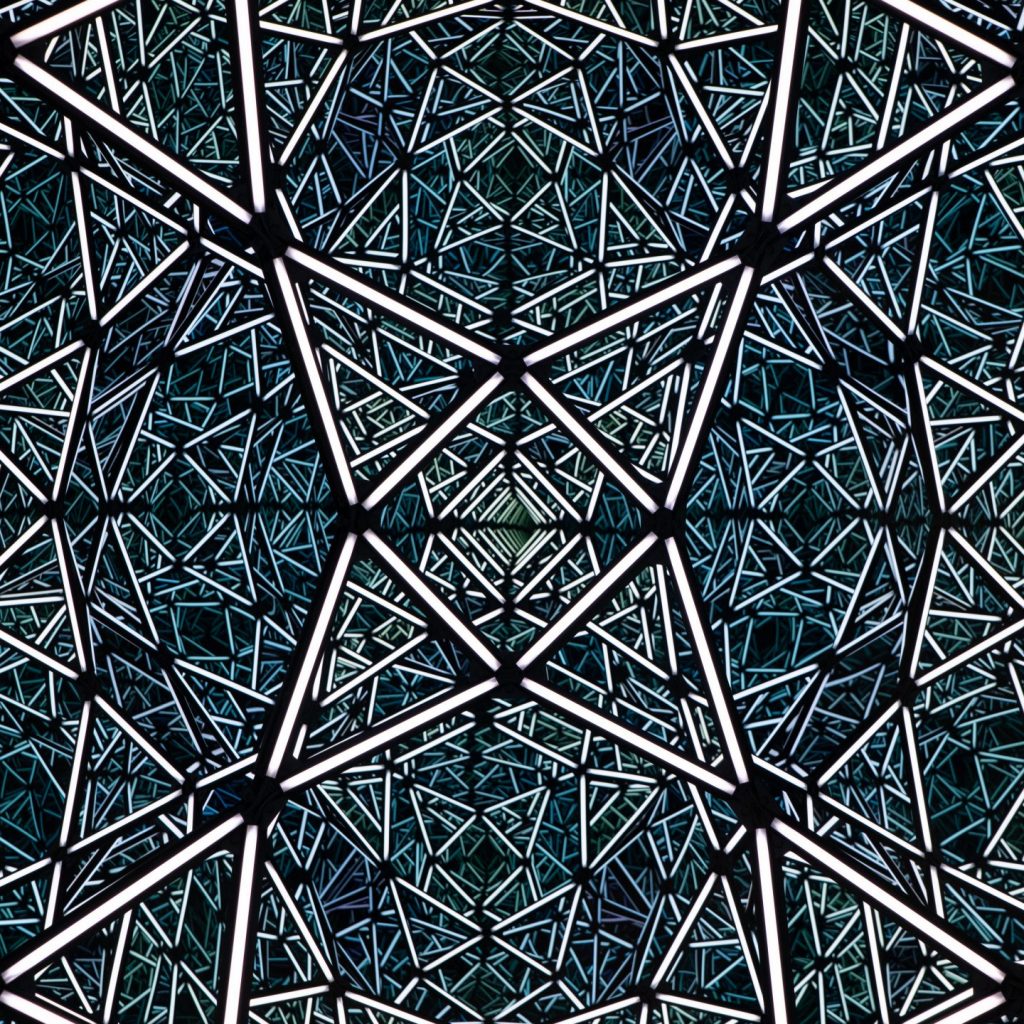Interview: Aesthetics and Therapeutics Lab
The collaborative video artist and therapist discuss contemporary dome art, and its ability to serve as a space of wonder, stimulation and healing
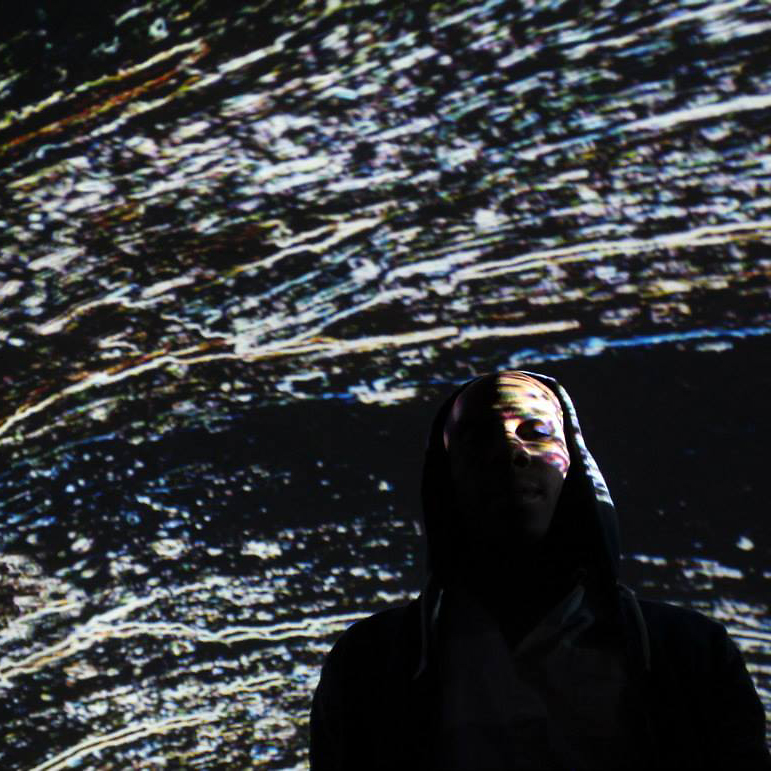
by Ikechukwu Casmir Onyewuenyi
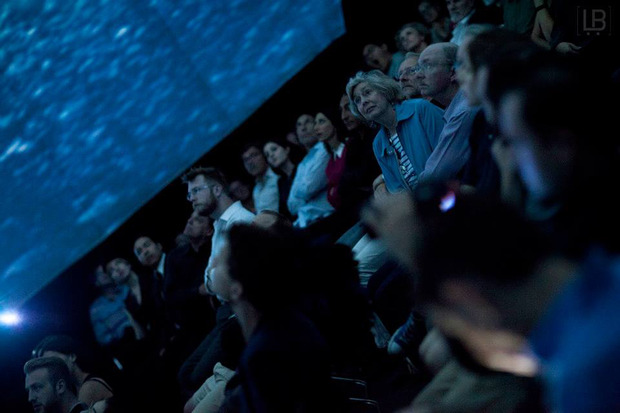
The last time CH spoke with video artist Jakob LeBaron Dwight, he remarked on the effects of light entrainment on the brain and the possible restorative value of light in the context of art. Dwight’s body of work has always manipulated light and its movement, but never dealt directly with how the medium serves to heal and promote feelings of well-being through interactive means.
Three years later, Dwight has teamed up with art therapist Dr Marina Masic to explore just that—namely the intersection of art and healing and where sensory experience finds itself within this nexus. It’s from this vantage point that Dwight and Masic’s newly minted collective, Aesthetics and Therapeutics Lab (ATL), aims to initiate experiments and installations that cross aesthetics and effective boundaries to sensitizing. Their mission was recently given life through a fulldome artist residency at LA’s Vortex Dome—a state-of-the-art facility specializing in production and design for effects, gaming, interactive, experiential themed entertainment—and its creative director, Ethan Bach.
This unparalleled residency provides hands-on tutelage on the innovative possibilities in dome technology, which allows for a range of visual and aural expressions. For ATL, the fulldome environment offers the necessary trappings to sculpt multi-sensory environments (MSEs) that combine sensorial explorations with a sanctuary setting. There’s an element of relational aesthetics or social architecture to MSEs, and ATL’s work places context on the visual, auditory, olfactory, tactile, vestibular and proprioceptive sensory systems, all the while ensuring that this sensory apéritif is constructive and never hazardous for the individual. The tailor-made yet controlled quality of MSEs ensures this form of immersive art spurs interactivity and possess novel, clinical implications for various populations, including those suffering from autism, traumatic brain injury, PTSD or developmental disabilities.
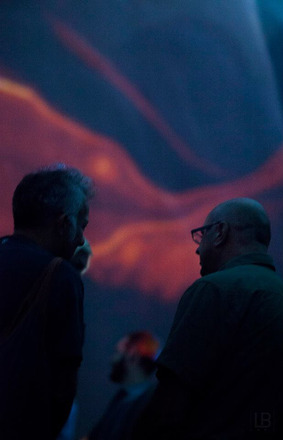
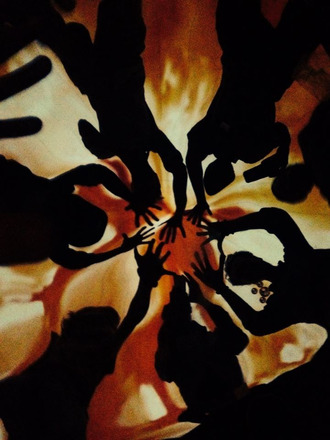
Fresh off “MORPHOS,” the Vortex Dome presentation that culminated at the end of the residence, Dwight and Masic spoke to us about the marriage between dome technology and MSEs and how this coming together might shape the expression and experience of art for curative purposes.
How has your early video work brought you to what seems like a nexus of immersive and interaction media that has leanings in social architecture?
Jakob Dwight: That’s a bit difficult because I think it’s been such an emergent course consisting of those individual directions that you mention just now, coming together to (in)form a body that I can’t quite define yet. As far as immersion, I’ve always thought of being a dream artist if it were possible to become such, that is, an artist working directly through the medium of dreams, forming dreams and immersive media like fulldome, or wearable virtual reality is maybe the next best thing to concocting a new hallucinogen or something to achieve that. Marina and I definitely meet up on dream space consciousness and it’s one of our modules.
And of course witnessing the evolution and eventual hegemony of video games within our culture has indeed piqued my interest in exploring interactivity, in cultivating a new way of expressing and receiving visual communication. For this project Marina and I really thought about interaction and what it means in experiencing art. We wanted to re-submit more naturalistic instances of interaction to the contemporary art discourse on (digital) interactivity: seeing and viewing, meditation and reflection, or the aforementioned form of interpretative moments inspiring joint attention and talking a work over with others in the room. Ultimately for us these were the most significant elements of interaction and a full art experience. So I can’t say that I’m completely championing interactive media per se, in that I still do very much believe in the more conventional “monologue” approach to making an artwork in front of the canvas or screen so to speak. A viewer bringing one’s own ideas, memories and experiences to it—that Duchampian completing of an artwork through interpretation—is still what I’m interested in.
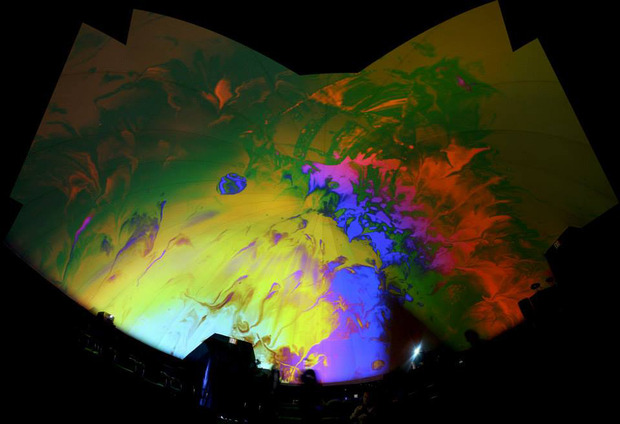
The fulldome residency seems like a logical next step in the dream trajectory since this realm of existence is often all-encompassing and heightened in terms of sensorial experience. What does it mean to you and what’s next for artists who want to continue to use fulldome?
JD: Dome and immersive art specialist Ethan Bach—whose residency program is the first of its kind in its aim to bring the visions of working artists into the dome space—continues to rally and create opportunities curating art in the dome through the recently formed International Fulldome Artists Alliance (IFAA). Its mission is to bring arts space into more of the 1,200 domes in the world that are typically and rather conservatively only used as scientific planetarium spaces. Through IFAA, which has a great team behind it, including Ed Lantz (founder of the Vortex Dome LA), hopefully more artists/creatives will be able to have the opportunity to explore the fulldome. If the IFAA doesn’t work through diplomatic means, we have formed the Dome Liberation Army (DLA) to take dome space back from dry science planetariums by force! [laughs]
But on a more serious note, it is extremely important to have enough access to the dome as an active studio because artwork can look completely different on the small screen than on the dome, which is a good bit larger than a cinema screen. There is a lot of ground to cover with the picture plane being so large, so in order to create an immersive experience the artist actually needs to be immersed during production to make coherent work. We think that any dome residency should take this into account and really give a good amount of “dome time” to resident artists for practice.
Marina Masic: It’s all a dynamic process in which we are getting to be pioneers, as the history of dome art is surprisingly short. The best advice we can share with other artists seeking to do this work is to grow your dome network and community, but we are seeing that this definitely will be a trail that has to be blazed rather than followed.
JD: Here at the residency we made it our goal to explore immersive media in general and, in addition to the dome, have experimented with the virtual reality headset Oculus Rift and other wearable similar devices. Use of such devices is another avenue for artists and creators to delve into immersive media and also make sure the art experience is represented in virtual reality alongside video games, films and military simulation.
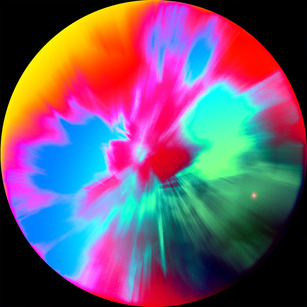
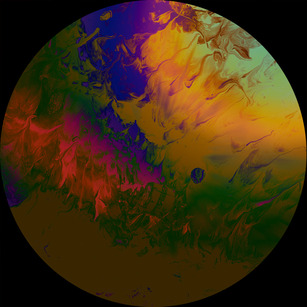
What work from ATL was on display at “MORPHOS”?
MM: We were working on four modules designed to illustrate different components of multi-sensory environments. In the first module, “Color Fields,” gradual color evolutions in varying intensities envelop the space and viewer. This module is inspired by concepts as far afield as chromotherapy, to contemporary research on the phenomena known as color obsession and color phobia in autism. In turn we create a narrative of color associations speaking to these varied concepts. Next we flow into “Light and Sound Environments,” and visually experiment with light mapping/tracking and spatialization around the dome, addressing the sense of proprioception and the vestibular system. The goal here is to link research on the latter two sensorimotor systems to light and sound therapy.
In the “Perception” module, the viewer is provided with another reflective space in which to cultivate imagination and space to process joint attention experiences through form interpretation depicted by abstract paintings in motion in the space (ie: asymmetrical Rorschach imagery). Lastly, we set up a model (“Dream Space Consciousness”) that we hope to realize with additional support in the future. It involves crafting a space that would house water for flotation and aqua-wellness purposes as well as integrate MSE principles based on the senses (visual, auditory, vestibular, etc). The work pays homage to Liquid Sound methodology and Micky Remann’s vision and manifestation, while parallelling the likes of Asclepius and the pilgrimage individuals made to these temples for oracular dreams, which were invoked by means of incubation.
All throughout the modules and the larger show we made a point to carefully curate our sound selection. Auditory sensation is an important aspect to MSEs, owing to its research basis, with brain entrainment literature highlighting how external stimuli (ie: sound) can orchestrate a desired brain state. We used technologies of binaural beats and isochronic tones to explore these brain entrainment purposes. Additionally, images were animated but allowed to follow natural rhythms and an “observatory speed” in which things move and change slowly as in atmospheric events like a sunset. This ensured that each audiovisual experience is given time to unfold within the percipient and time for therapists or a caregiver to notice reactions. Building on this last point, MSEs are a way for a therapist to take notes and ultimately construct a “sensory diet” or palette of what things make a subject comfortable or uncomfortable, or the flow of information easier or harder to comprehend. In the case of autistic populations, MSEs can determine which things—toys, smells, sounds—they most engage with.
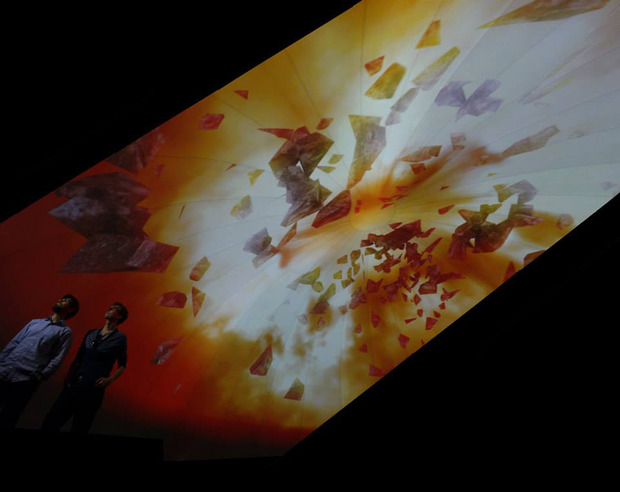
JD: Just to add, this speed of slow change was factored into a review on “dome etiquette,” which looked at how to set up a general immersive art communication protocol. There’s a concept Ethan referred us to from his experiences called “immersion fatigue”—or overstimulation—whereby human beings get tired from the experience of immersion itself. This was first noticed by the military when utilizing virtual reality for battle simulation. Also, quick or rapid-fire cuts (ie: the blip style of editing music videos in the ’80s) doesn’t work so much in the dome as it is entirely jarring to viewers. So there’s a lot of accountability for dome artists in this way in that they are “in control” of a large percent of—if not the entirety of—a percipient’s field of view, so this should be addressed to avoid overstimulation, vertigo and fatigue that can occur for both neurotypical viewers as well as the populations that we will be addressing with therapeutic intent.
Given this panoply of sensory stimulation, the curative aspect of MSEs within a fulldome space seems counterintuitive. However, dome etiquette and discerning the sensory biography of an individual ensures the experience is amenable to say clinical interests.
MM: Yes, every MSE experience is closely connected to a person’s sensory diet. The artificial space of MSE is based on the pleasure principle promoting stress reduction primarily, as well as stimulation and novelty for growth. We are interested in gauging immersion in this scale and made an active effort to take surveys of reactions and reflections as we revisit sensory experiences through art, media and technology.
From a clinical standpoint, stress reduction and constructing valuable responses to traumas and external stimuli is a theme common to each population that we will be addressing. We are focusing on what can be done to help individuals organize sensory information, discovering which modality helps the individual to grow most in a meaningful way. Note the MSE is not intended to be simple or merely comforting because this could reinforce preexisting patterns. It is imperative to initially communicate to the participant the changes that will take place and its purpose for preparedness sake, encouraging an active participation mode.
For the MORPHOS show, did you test your MSE on a particular clinical population?
MM: We decided to focus our efforts on creating a shared experience for the general population and give an overview of our planned approach to the lab and our experiments.
Will you lean toward the passive or interactive aspects of the MSE, or will it be a mix of both?
MM: It’s passive at first, like an art gallery experience may be. We are very keen to lend the reflective space that the contemporary arts pace is founded upon and would like to introduce this space of wonder, leisure and reflection to therapy. From the passive it can become more interactive: individuals are encouraged to do whatever they wish—lie down (which we personally prefer for ourselves), walk around, sit, and to follow interests and engage or disengage freely.
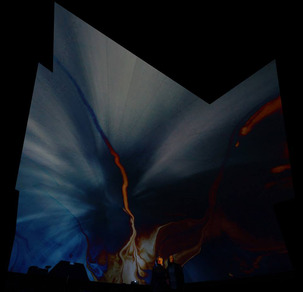
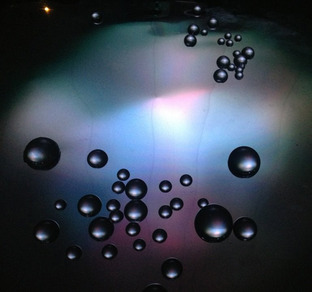
How does being in the fulldome space alter (for better or worse) this therapeutic experience that MSE was initially designed for?
MM: The dome is useful in that it is able to allow users to orient themselves in space. For instance, in our “Light and Sound Environment” module, and looking at it from an occupational therapy perspective, it could be immensely helpful for a percipient to actually move their bodies, head and neck, to track light around the space.
JD: Also there is a tendency to lose oneself in immersive fulldome imagery which can lead to a level of comfort in itself that can make a session flow easier. We ultimately would like to see health providers like hospitals and planetariums alike look into the idea of the dome as a potential healing space. MoMA PS1’s embracing of the dome form as art space in the last few years has been a point of inspiration and gave a glimpse of what full dome art experience could be.
MM: We wish for it to be geared toward a wellness and art experience. The processes discussed in MSE are multifaceted, and organically therapeutic, though they access media—it’s this lovely bridge of using technology in an effort to connect with sensitizing and the self. The work of noted neuroscientist, Antonio Damasio, illustrates the historic evolutionary example of eukaryotic cells, organisms compelled into movement as a result of sensing change and restructuring after experiencing the environment. We wish to mirror the powerfully restorative capabilities of a being by promoting work focused on the senses. Our overall aim is to present the viewer with an experiential model and link our correlating philosophies and concepts as extensions.
Images courtesy of Aesthetics and Therapeutics Lab


